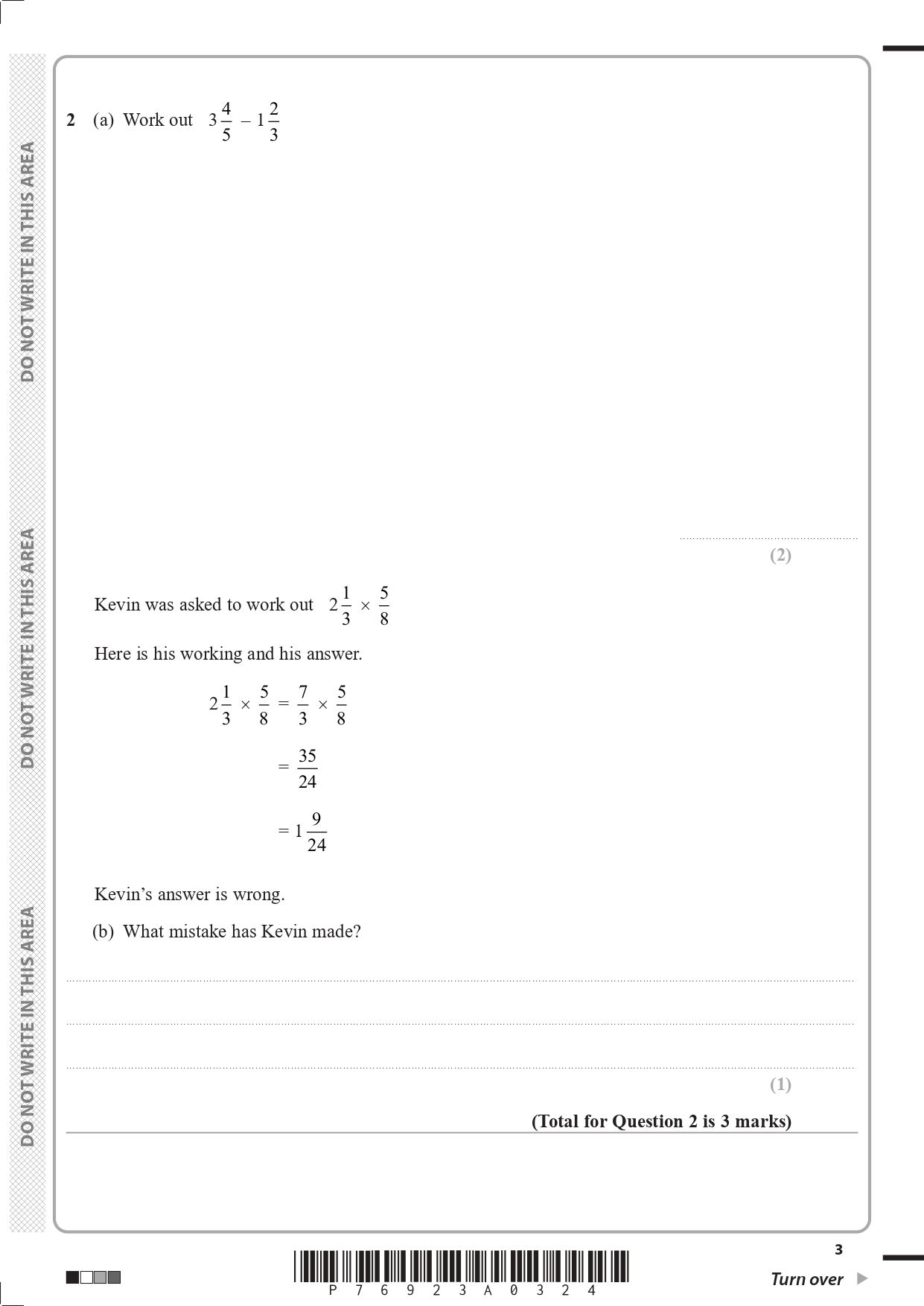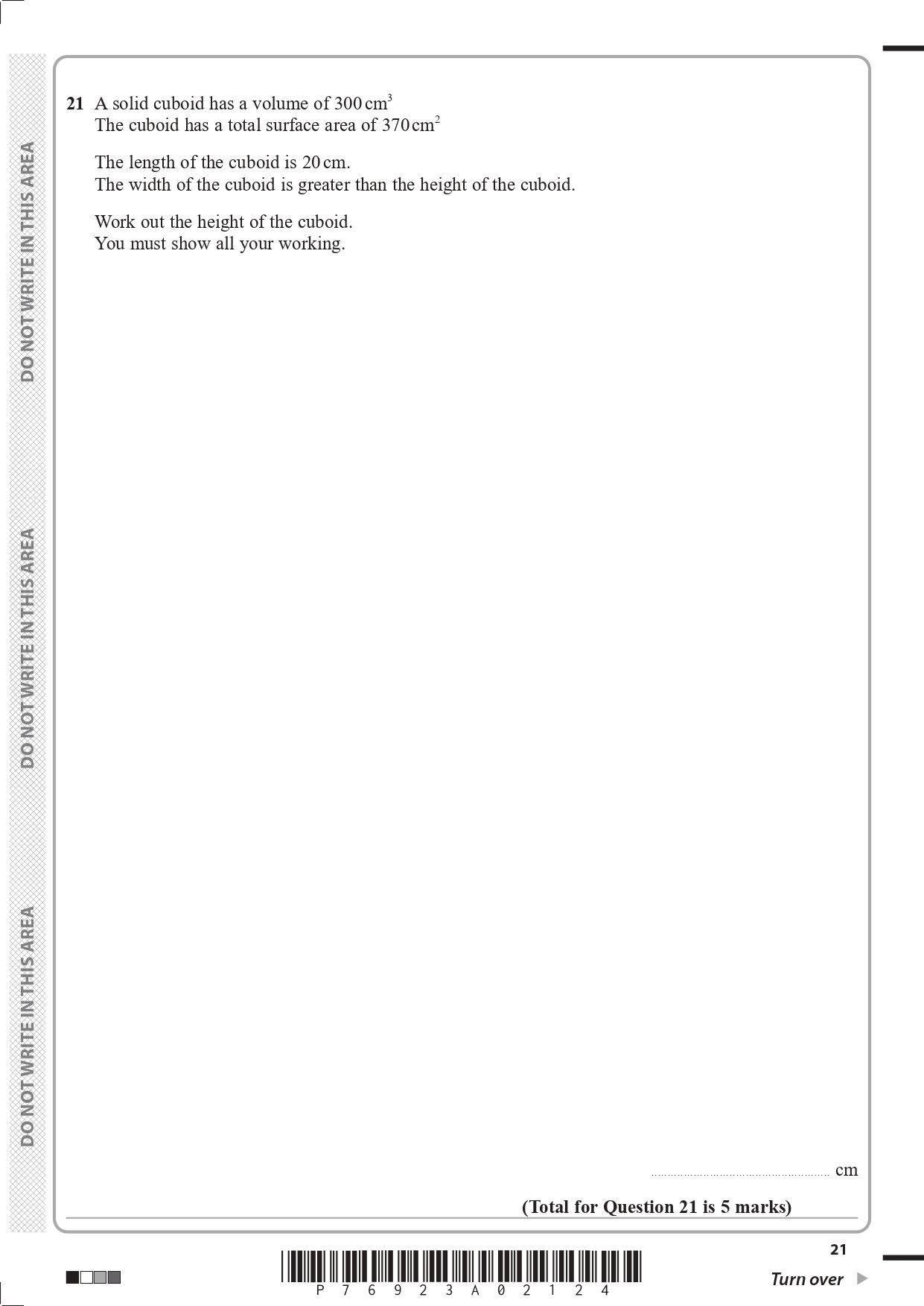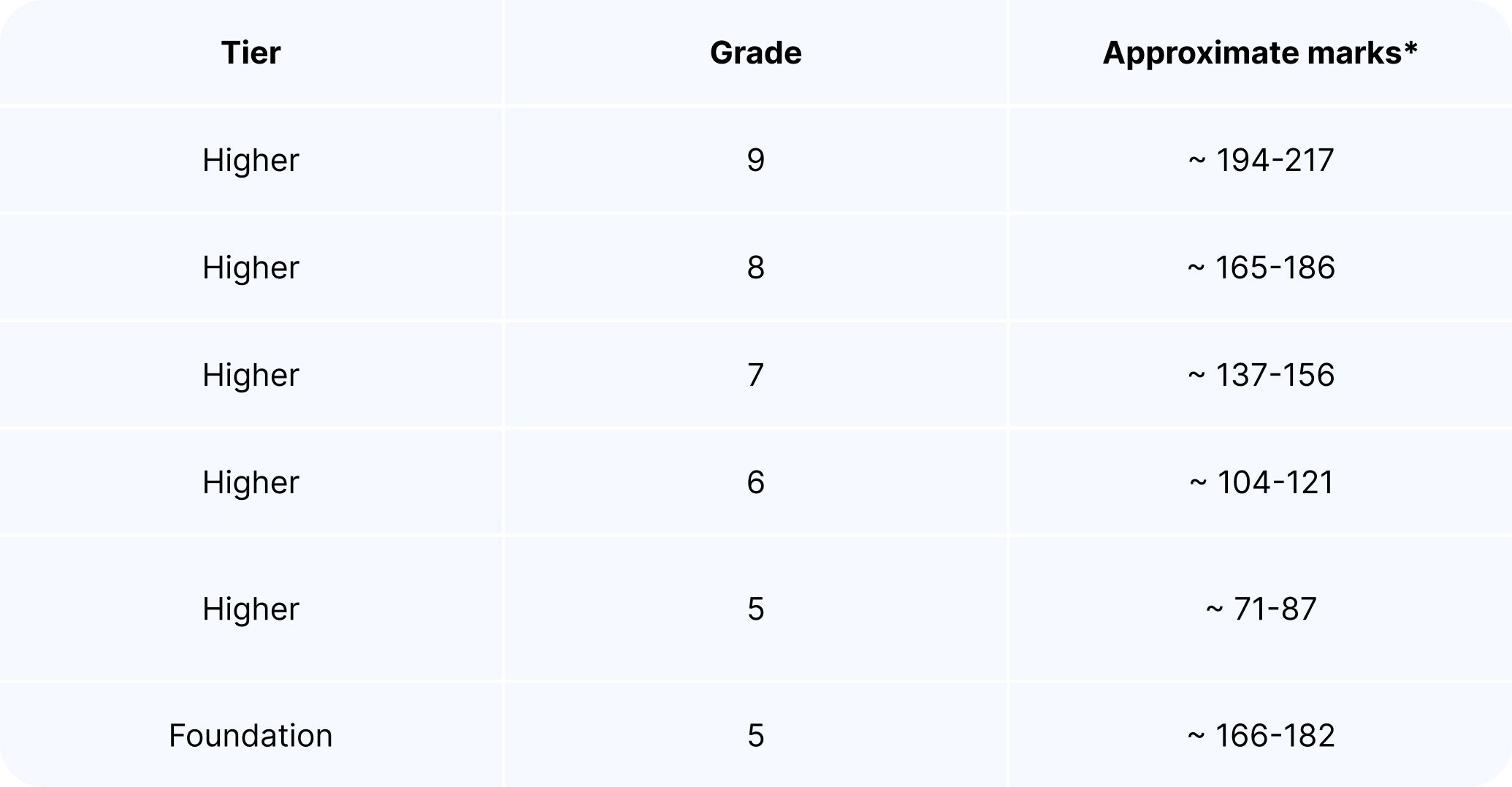Contents
Edexcel Maths GCSEs are on the horizon. Whether you’re looking for revision help or just curious to know what the exam will look like, take a look at this guide to the Edexcel Maths exam.
Not sure which exam board your school uses? Take a look at our guide to finding out which exam board you’re studying.
Key takeaways:
There are three papers for Edexcel Maths GCSE. Each is 90 minutes long and worth 80 marks.
The grade boundaries for Edexcel Maths are set after the exams take place.
A formula sheet will be provided for Maths GCSEs in 2025, 2026, and 2027.
What’s the format for the Edexcel Maths GCSE?
The format for Edexcel Maths is similar to other exam boards and consists of:
Three exam papers, each worth a total of 80 marks.
Paper 1 is a non-calculator exam, with papers 2 and 3 allowing calculators.
Each paper lasts 90 minutes (1 hour and a half).
There are 240 marks available, with each paper contributing to a third of your final grade.
All content from the Edexcel GCSE Maths course can be tested in any of the three exam papers, with questions often combining topics from across the curriculum.
Free revision timetable template & more
Less stress, more success! Get your free revision timetable templates and guide to effective revision today. Because great revision starts with a solid plan.
What’s the difference between Higher and Foundation for Edexcel Maths?
Like other exam boards, Edexcel splits its papers into a Higher and a Foundation tier.
Foundation tier Maths Edexcel:
Covers the essential topics such as Algebra, Geometry and Statistics that students need to know for further study, work, and everyday life.
In Foundation Maths, the highest grade you can achieve is a 5.
Higher tier Maths Edexcel:
The higher tier covers topics at a more advanced level, such as more complex Algebra, higher-level Geometry, and deeper Functions.
For Higher tier Maths, you can achieve up to a grade 9 - the highest grade possible.
In terms of question types and difficulty for Higher and Foundation papers:
The Foundation papers tend to have more structured questions and less depth in certain topics.
The Higher tier contains more challenging algebra and harder problem solving.
As with most GCSE Maths exams, questions progress from easier to harder, with early marks secured via routine tasks and later marks involving multi-step reasoning or interpretation.
Since Paper 1 is non-calculator, you’ll see arithmetic, fractions, simplifying, factorising, basic calculations, and mental methods tested without calculator support.
In all papers, ‘method marks’ are often available, given for showing how you worked out a question, not just a correct answer.
Your school will place you in either the Foundation or Higher tier based on your Maths attainment in Year 9, although you can be moved up or down a tier during Years 10 or 11. You must take all three papers at the same level.
Edexcel offers Further Maths at GCSE as part of its International GCSEs; check with your school to find out if this is an option you could take.
What does the exam paper look like?
Each paper will include:
An instructions page: This is where students will need to fill in their personal details and where they can read through the materials, instructions, information and advice for each Edexcel Maths paper.
The question booklet: This will include all the questions and where students will write their answers and show their working out.
Additional pages: These are for extra space to include working out, if needed. You must write the question number in the left-hand margin to ensure you don’t lose marks.
What kinds of questions are there?
For each of the papers, a mix of GCSE maths questions will appear. The difficulty increases as you progress through the paper.
Towards the start of the paper, short, one or two-mark questions will appear:

Pictured: Higher Tier, Paper 1 Edexcel GCSE Maths June 2024.
As you progress through the paper, multi-step problems with more marks will be included, requiring deeper thinking:

Pictured: Higher Tier, Paper 1 Edexcel GCSE Maths June 2024.
Each paper is worth 80 marks total. Remember that the number of marks dictates the type of question and what you need to show.
Take a look at this breakdown:
1-mark questions:
These are often simple recall, single-step arithmetic, or quick fact questions.
They test basic skills: e.g. “Write ⅗ as a decimal,” “What is 7 × 8?”, “Calculate 15% of 80.”
They don’t require extended working. One line or even just the answer is enough (though working is beneficial in case of slips).
They’re designed to build confidence early in the paper.
Medium-mark questions (2–5 marks):
These questions require a few more steps to solve, and ask students to demonstrate more thought and understanding.
You may need to show intermediate workings or justify a step.
The mark scheme will award method marks (for correct setup or steps) as well as final answer marks.
Higher-mark, multi-step / reasoning questions (6, 7, 8+ marks):
These ask you to combine multiple areas of Maths - Algebra, Geometry, Statistics, or Ratio - in context.
They often include “show that”, “explain why”, “prove”, or “justify” wording.
You must lay out a clear method, break down steps, and sometimes consider alternative approaches or show reasoning.
Marks are split into different types. You can earn method marks for showing the correct steps and working, and accuracy marks for getting the right answers.
Even if the final answer is wrong, partial marks can be earned for correct working.
What are the grade boundaries for Edexcel Maths GCSE?
It’s important to remember that the exact grade boundaries for your GCSE exams will change every year. Exam boards adjust the grade boundaries after an exam has happened, depending on how advanced the exam content was and how the cohort performed.
This is so students don’t have an advantage or disadvantage because of the year they took the paper. For example, if your paper were harder, grade boundaries would be lowered so that a grade 5 reflects the same level of knowledge as in previous years.
Let’s take a look at the grade boundaries for Edexcel Maths in recent years to get a sense of how grades are awarded:

Although we can’t tell you the exact boundaries for the next exam, this table should give you an idea of what kind of marks you’ll need for your target grade.
Learn more: take a look at our blog on how GCSE exams are graded.
Where can I find past papers and mark schemes?
Practising with Edexcel past papers and mark schemes is one of the most effective ways to prepare for GCSE Maths. Past papers help you understand the question style, see how marks are awarded, and build confidence with real exam timing and structure.
Head to the Edexcel website to find past papers and mark schemes from previous GCSE Maths exams.
What key topics do I need to know for Edexcel Maths GCSE?
Each of the three Edexcel Maths papers covers a range of topics. You’ll need a thorough understanding of each to achieve top marks, so make sure you revise any areas you find tricky ahead of the exams.
The main topic areas are:
Number: Includes measures and accuracy, fractions, decimals and percentages, and number structure and calculation.
Algebra: Includes notation, vocabulary and manipulation, graphs, solving equations, and sequences.
Ratio, proportion and rates of change: Includes using scale diagrams, reducing ratios and more.
Geometry and measures: Includes properties and constructions, measuring and calculation, and vectors.
Probability: Includes constructing possibilities for experiments, recording, describing and analysing relative frequencies and more.
Statistics: Includes analysing population statistics, interpreting charts and graphs and more.
Check out the Edexcel GCSE Maths specification for the full list.
What are examiners looking for?
For Edexcel GCSE Maths papers, examiners aren’t just checking for the right answers; they want to see how you think. They’re looking for clear working, sensible explanations and answers that show genuine understanding of the questions.
Every question on the paper is written to show examiners what you can really do. Each question tests one or more of the three Assessment Objectives (AOs), which we’ve laid out below to help you prepare.
The three assessment objectives are:
1. AO1 – Use and apply standard techniques
Students should be able to:
Accurately recall facts, terminology and definitions.
Use and interpret notation correctly.
Accurately carry out routine procedures or set tasks requiring multi-step solutions.
2. AO2 – Reason, interpret and communicate mathematically
Students should be able to:
Make deductions, inferences and draw conclusions from mathematical information.
Construct chains of reasoning to achieve a given result.
Interpret and communicate information accurately.
Present arguments and proofs.
Assess the validity of an argument and critically evaluate a given way of presenting information.
3. AO3 – Solve problems with Maths in context
Students should be able to:
Translate problems in mathematical or nonmathematical contexts into a process or a series of mathematical processes.
Make and use connections between different parts of mathematics.
Interpret results in the context of the given problem.
Evaluate methods used and results obtained.
Evaluate solutions to identify how they may have been affected by assumptions made.
Every Edexcel Maths paper provides you with the opportunity to demonstrate what you truly understand. The best way to impress examiners is to approach each question step by step, show the working clearly, and check that your answers make sense.
By practising this approach regularly, you build the habits examiners look for: clear working, logical thinking, and confidence in tackling unfamiliar problems. It’s these skills, developed over time, that help turn preparation into strong, well-earned marks on exam day.
Is there a formula sheet for GCSE Maths?
Edexcel provides an “Exam Aid” booklet to all students during the exams. The DfE has confirmed that formula sheets will continue to be provided for Maths exams in 2025, 2026 and 2027.
The booklet contains formulas for areas, volumes, circles, Pythagoras’ Theorem, compound interest and probability. This is for all students at both Higher and Foundation tiers. Take a look at the 2025 booklet here.
Preparing for Edexcel Maths GCSE will be a little easier now that you know what to expect on the exam. Using past papers and mark schemes, you can build your exam confidence effectively. Remember, thorough revision will help you ace your exams on the day. Good luck!
Don’t miss Atom’s GCSE giveaway!

Six months. Six epic prizes. Six chances to make the GCSE season unforgettable.
We’re launching Atom for GCSE prep in 2026, and to celebrate, over the next six months, we’re giving away thousands of pounds worth of prizes to help your child level up their GCSE revision.
Here’s a taste of what’s up for grabs:
The latest Apple tech, including an iPad Air, Vision Pro and more
Festival tickets for Boardmasters and Reading 2026
Europe interrail passes and £1,000 spending money
…and that’s just a few of the amazing prizes available.
Our first two winners have already taken home incredible prizes! Find out who they are and what they won in our latest giveaway update and keep an eye out for news of our November winner.
It’s free to join. UK only. Full T&Cs apply.
Contents
